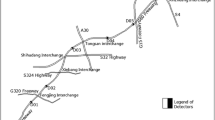Abstract
This study develops new real-time freeway rear-end crash potential predictors using support vector machine (SVM) technique. The relationship between rear-end crash occurrences and traffic conditions were explored using historical loop detector data from Interstate-894 in Milwaukee, Wisconsin, USA. The extracted loop detection data were aggregated over different stations and time intervals to produce explanatory features. A feature selection process, which addresses the interaction between SVM classifiers and explanatory features, was adopted to identify the features that significantly influence rear-end crashes. Afterwards, the identified significant explanatory features over three separate time levels were used to train three SVM models. In the end, the multi-layer perceptron (MLP) artificial neural network models were used as benchmarks to evaluate the performance of SVM models. The results show that the proposed feature selection procedure greatly enhances the accuracy and generalization capability of SVM models. Moreover, the optimal SVM classifier achieves 81.1% overall prediction precision rate. In comparison with MLP artificial neural networks, SVM models provide better results in terms of crash prediction accuracy and false positive rate, which confirms the superior performance of SVM technique in rear-end crash potential prediction analysis.
Similar content being viewed by others
References
MADANAT S, LIU P C. A prototype system for real-time incident likelihood prediction [R]. Washington D.C.: DEA Project Final Report (ITS-2). Transportation Research Board of the National Academies, 1995.
OH C, OH J, RITCHIE S, CHAN M. Real-time estimation of freeway accident likelihood [C]//CD-ROM, Transportation Research Board of the National Academies. Washington D.C., 2001.
LEE C, SACCOMANNO F, HELLINGA B. Analysis of crash precursors on instrumented freeways [J]. Transportation Research Record: Journal of the Transportation Research Board, 2002, 1784: 1–8.
LEE C, HELLINGA B, SACCOMANNO F. Real-time crash prediction model for application to crash prevention in freeway traffic [J]. Transportation Research Record: Journal of the Transportation Research Board, 2003, 1840: 67–77.
PANDE A, ABDEL-ATY M. Classification of real-time traffic speed patterns to predict crashes on freeways [C]//CD-ROM, Transportation Research Board of the National Academies. Washington D.C., 2004.
ABDEL-ATY M, UDDIN N, PANDE A, ABDALLA F, HSIA L. Predicting freeway crashes from loop detector data by matched case-control logistic regression [J]. Transportation Research Record: Journal of the Transportation Research Board, 2004, 1897: 88–95.
ABDEL-ATY M, UDDIN N, PANDE A. Split models for predicting multivehicle crashes during high-speed and low-speed operating conditions on freeways [J]. Transportation Research Record: Journal of the Transportation Research Board, 2005, 1908: 51–58.
GOLOB T F, RECKER W W. Relationships among urban freeway accidents, traffic flow, weather, and lighting conditions [J]. Journal of Transportation Engineering, 2003, 129: 342–353.
GOLOB T F, RECKER W W. A method for relating type of crash to traffic flow characteristics on urban freeways [J]. Transportation Research Part A: Policy and Practice, 2004, 38: 53–80.
XU Cheng-cheng, WANG Wei, LIU Pan. A genetic programming model for real-time crash prediction on freeways [J]. IEEE Transactions on Intelligent Transportation Systems, 2013, 14(2): 574–586.
SUN Jie, SUN Jian. A dynamic bayesian network model for real-time crash prediction using traffic speed conditions data [J]. Transportation Research Part C: Emerging Technologies, 2015, 54: 176–186.
PANDE A, ABDEL-ATY M. Comprehensive analysis of the relationship between real-time traffic surveillance data and rear-end crashes on freeways [J]. Transportation Research Record: Journal of the Transportation Research Board, 2006, 1953: 31–40.
PANDE A, ABDEL-ATY M. Assessment of freeway traffic parameters leading to lane-change related collisions [J]. Accident Analysis & Prevention, 2006, 38: 936–948.
VAPNIK V N. The nature of statistical learning theory [M]. New York: Springer-Verlag, 1995.
FANG Yuan, CHEU Ruey Long. Incident detection using support vector machines [J]. Transportation Research Part C, 2003, 11: 309–328.
ZHANG Yun-long, XIE Yuan-chang. Forecasting of short-term freeway volume with v-support vector machines [J]. Transportation Research Record: Journal of the Transportation Research Board, 2007, 2024: 92–99.
LI Xiu-gang, LORD D, ZHANG Yun-long, XIE Yuan-chang. Predicting motor vehicle crashes using support vector machine models [J]. Accident Analysis and Prevention, 2008, 40: 1611–1618.
LI Zhi-bin, LIU Pan, WANG Wei, XU Cheng-cheng. Using support vector machine models for crash injury severity analysis [J]. Accident Analysis & Prevention, 2012, 45: 478–486.
VAPNIK S V N. The support vector method of function estimation [M]. New York: Springer-Verlag, 1998.
BURGES C J C. A tutorial on support vector machines for pattern recognition [M]. New York: Springer-Verlag, 1998.
CHANG Chih-chung, LIN Chih-jen. LIBSVM: A library for support vector machines [M]. ACM, 2011.
CHEN Yi-wei, LIN Chih-jen. Combining SVMs with various feature selection strategies [J]. Studies in Fuzziness & Soft Computing, 2006, 207: 315–324.
HOURDOS J N, GARG V, MICHALOPOULOS P G, DAVIS G. Real-time detection of crash-prone conditions at freeway high-crash locations [J]. Transportation Research Record: Journal of the Transportation Research Board, 2006, 1968: 83–91.
Author information
Authors and Affiliations
Corresponding author
Additional information
Foundation item: Project(BK20160685) supported by the Science Foundation of Jiangsu Province, China; Project(61620106002) supported by the National Natural Science Foundation of China
Rights and permissions
About this article
Cite this article
Qu, X., Wang, W., Wang, Wf. et al. Real-time rear-end crash potential prediction on freeways. J. Cent. South Univ. 24, 2664–2673 (2017). https://doi.org/10.1007/s11771-017-3679-2
Received:
Accepted:
Published:
Issue Date:
DOI: https://doi.org/10.1007/s11771-017-3679-2




